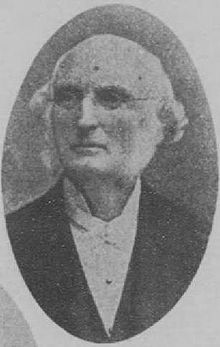Samuel Robbins Brown
Samuel Robbins Brown | |
|---|---|
 Rev. Samuel Robbins Brown | |
| Born | June 16, 1810 |
| Died | June 20, 1880 (aged 70) |
| Nationality | American |
| Known for | Christian Missionary to China and Japan |
Rev. Samuel Robbins Brown D.D. (June 16, 1810 – June 20, 1880) was an American missionary to China and Japan with the Reformed Church in America.
Birth and education
Brown was born in
China
In 1838, he went to
Return to America
After nine years' service, his wife's health failing, Brown returned to the United States and became a pastor at Sand Beach Church and teacher of boys at Owasco Outlet, near Auburn (1851–59). He worked for the formation of a college for women, which was situated first in Auburn and then in Elmira, New York and now known as Elmira College.[1] Brown was responsible for sponsoring Yung Wing (1828-1912); the first Chinese student to graduate from a U.S. university, graduating from Yale College in 1854.[1]
Japan
Brown and Hepburn, both benefiting from the experience of living and working in China, were noted pioneers in the study of the Japanese language. In collaboration with Dr. Hepburn and others, Brown made substantial contributions to the translation of the
Brown began presiding at Christian ecumenical religious services held at the Jobutsuji in Kanagawa from the second Sunday after his arrival in November 1859.[5] In July 1860, at the request of English-speaking merchants in Yokohama, Brown begun to preach regularly at Sunday morning service that attracted 30 to 40 congregants each week.
In 1861 Brown also contributed to drawing up the plans and specifications for the British
At Yokohama, Brown also opened a school in which hundreds of young men, afterwards leaders in various walks of life, were educated. Brown acted as honorary chaplain to the United States legation, teaching and preaching for over 20 years. He was one of the founders of the
Following a fire that destroyed much of his home, personal library, manuscripts, and notes, Brown returned to the United States for a two-year furlough in May 1867.[1] In June of the same year he was awarded an honorary Doctorate in Divinity by New York University.
Brown returned to Japan in 1869, arriving at Yokohama on August 26, to take up a new position as principal of a government funded school in
Brown, suffering from ill health, left Japan for the United States in the Autumn of 1879.
Death
Brown died during his sleep, while visiting an old friend in Stockbridge, Massachusetts, and is buried at Monson, Massachusetts, his boyhood home.
References
- ^ a b c Cornelia E. Brooke (January 1975). "National Register of Historic Places Registration: Sand Beach Church". New York State Office of Parks, Recreation and Historic Preservation. Retrieved November 10, 2009.
- ^ Griffis, William Elliot (1902). A Maker of the New Orient. New York: Fleming H. Revell Company. p. 147.
- ISBN 978-0-7748-1647-2.)
{{cite book}}: CS1 maint: multiple names: authors list (link - ISBN 4-925080-28-8.
- ^ Griffis, William Elliot (1902). A Maker of the New Orient. New York: Fleming H. Revell Company. p. 166.
- ^ Griffis, William Elliot (1902). A Maker of the New Orient. New York: Fleming H. Revell Company. p. 178.
Bibliography
- William Elliot Griffis, A Maker of the New Orient (New York: F.H. Revell, 1902) Internet Archive Etext
Works
- Colloquial Japanese (1863), a grammar, phrase book, and vocabulary
- Prendergast's Mastery System Adapted to the Japanese
- translation of Arai Hakuseki's Sei Yo Ki Bun: or, Annals of the Western Ocean
 This article incorporates text from a publication now in the New International Encyclopedia(1st ed.). New York: Dodd, Mead. p. 562.
This article incorporates text from a publication now in the New International Encyclopedia(1st ed.). New York: Dodd, Mead. p. 562.
